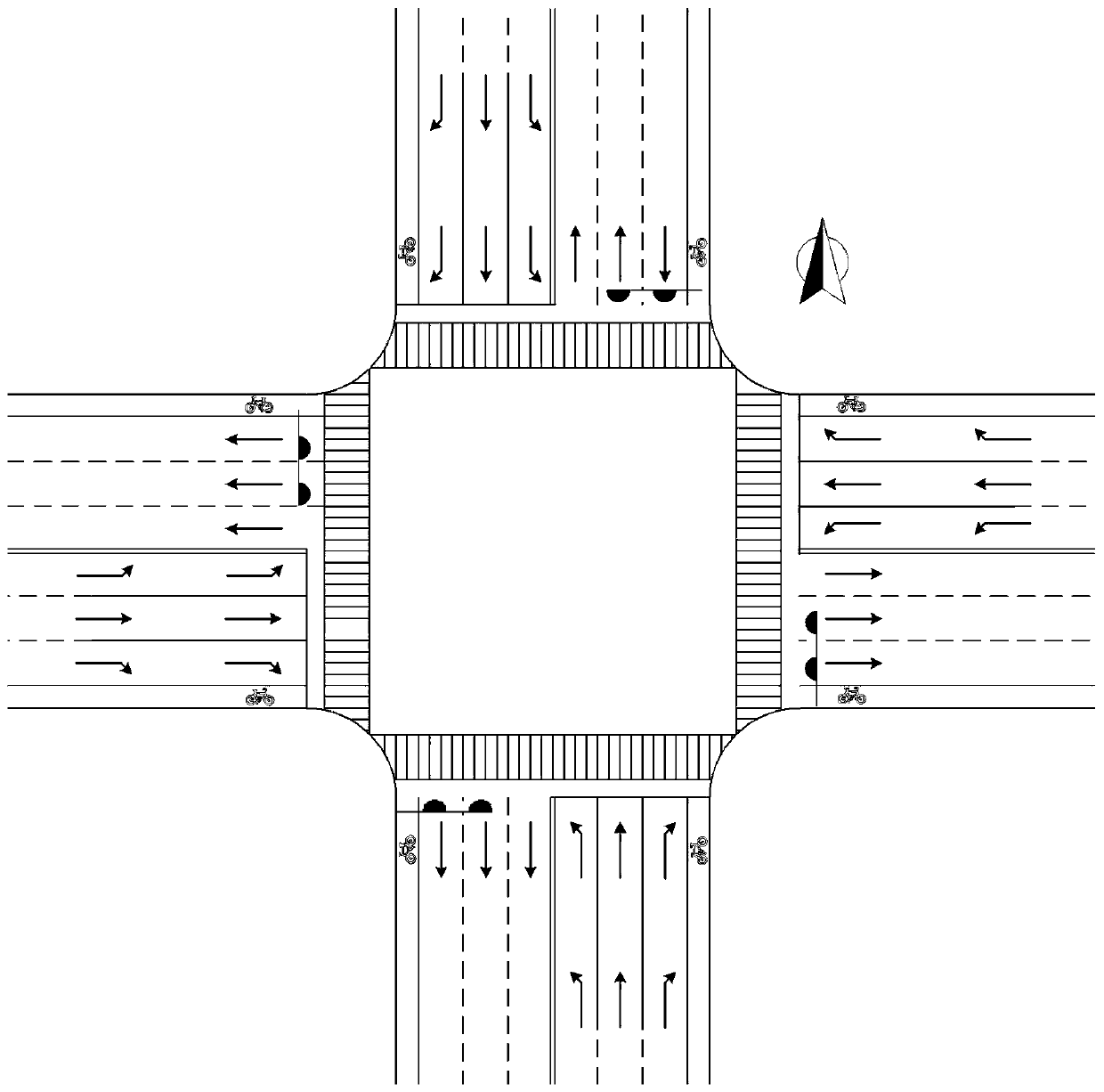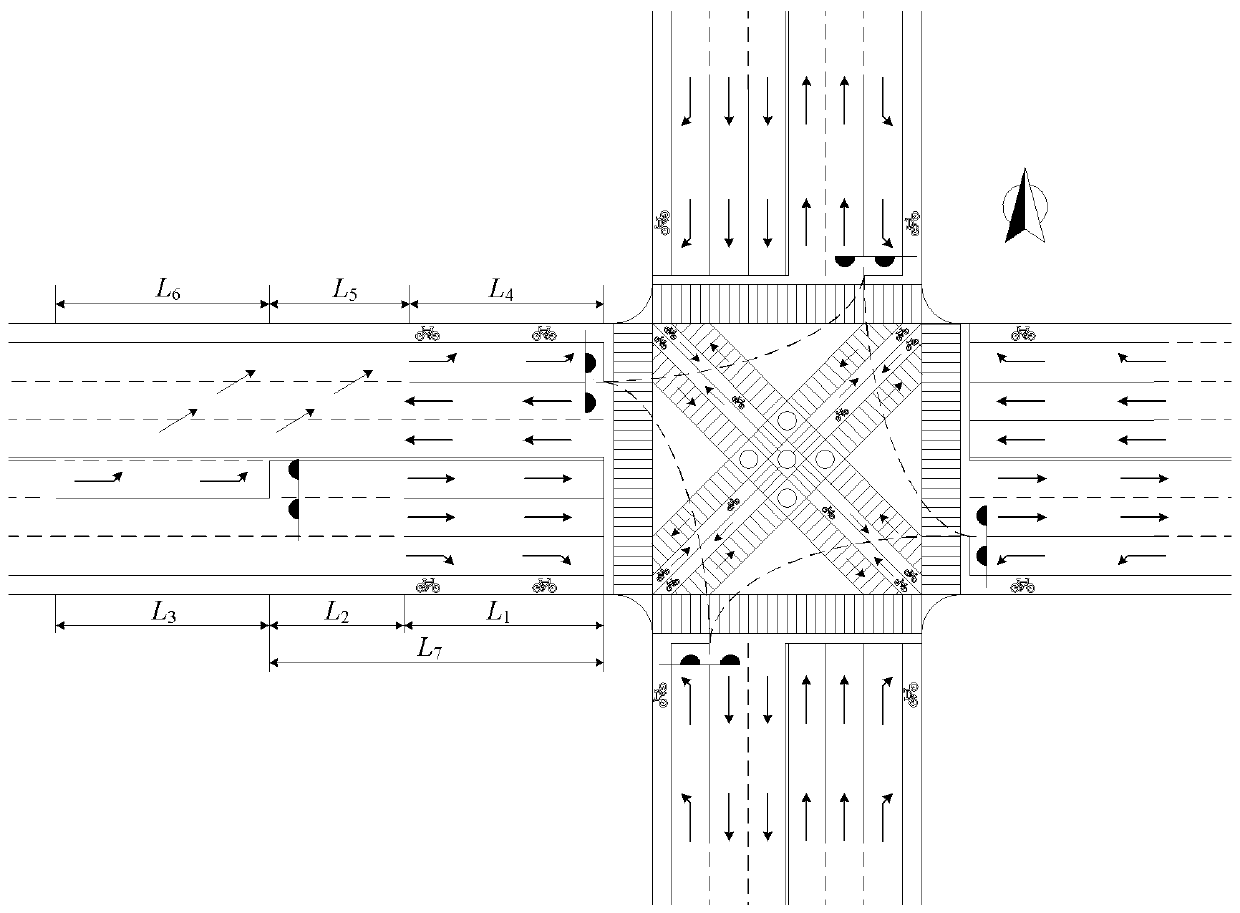Advance left-turn traffic control method at road intersection section
A technology of intersections and road sections, applied in the field of traffic control at road intersections, can solve problems such as non-compliance with non-motor vehicles and pedestrians, no systematic analysis, no consideration of non-motor vehicles and pedestrian traffic organization and traffic methods, etc., to achieve Improve traffic order and safety, improve traffic efficiency, and improve safety effects
- Summary
- Abstract
- Description
- Claims
- Application Information
AI Technical Summary
Problems solved by technology
Method used
Image
Examples
Embodiment 1
[0027] The lane layout of conventional urban road intersections is as follows: figure 1 shown. When the left-turn traffic flow at the intersection is large, it is necessary to set up a left-turn special lane and a left-turn special phase, thus forming a four-phase signal control mode. Under this control mode, non-motor vehicles and pedestrians at each entrance of the intersection pass through in phase with straight-going and left-turning motor vehicles. The phase diagram of conventional urban road intersection signal is as follows: figure 2 shown.
[0028] The traffic control method of the road section ahead of the left-turn lane in the present invention, by setting the advance left-turn lane on the road section and coordinating with the intersection signal to control the straight and left conflicting traffic flow at the intersection, it is different from the prior art in that : Considering the passage space and route of non-motor vehicles and pedestrians, set X-shaped zeb...
Embodiment 2
[0033] see image 3 , Figure 4 , the traffic control method of the road intersection section in this embodiment is different from Embodiment 1 in that: for general urban road intersections, the left-turn lane is set in advance through the intersection at first, and the machine inside the intersection is changed. The four phases of motor vehicles are two phases, and then one of the other two motor vehicle phases is used as the special passage phase for non-motor vehicles and pedestrians inside the intersection, and the X-shaped zebra crossing for non-motor vehicles and pedestrians inside the intersection is set to realize the intersection Internal straight-going and left-turning non-motor vehicles and pedestrians pass directly and quickly. In this case, the channelization method of the intersection is as follows image 3 As shown, the signal phase diagram is as Figure 4 shown.
[0034] For an intersection located in the commercial center of the city, if there are a large n...
Embodiment 3
[0036] see image 3 , Figure 4 , the traffic control method for road intersections in this embodiment is different from Embodiment 1 in that: for intersections located in the commercial center of the city and using pedestrian three-dimensional crossing facilities (pedestrian overpasses or tunnels), in order to ensure a large number of One or two of the other two motor vehicle phases are used as special phases for non-motor vehicles, and the non-motor vehicles that turn left turn directly to the left, which can ensure that non-motor vehicles pass through the intersection quickly. In this case, the intersection channelization method is as follows: Image 6 shown.
[0037] Adopting the one- or two-time special phase design for non-moving vehicles and pedestrians proposed in this design can also avoid the construction of pedestrian three-dimensional street crossing facilities. On the one hand, it reduces the construction cost, and on the other hand, it can also reduce the impac...
PUM
 Login to View More
Login to View More Abstract
Description
Claims
Application Information
 Login to View More
Login to View More - R&D
- Intellectual Property
- Life Sciences
- Materials
- Tech Scout
- Unparalleled Data Quality
- Higher Quality Content
- 60% Fewer Hallucinations
Browse by: Latest US Patents, China's latest patents, Technical Efficacy Thesaurus, Application Domain, Technology Topic, Popular Technical Reports.
© 2025 PatSnap. All rights reserved.Legal|Privacy policy|Modern Slavery Act Transparency Statement|Sitemap|About US| Contact US: help@patsnap.com



